Issued by Chinese Academy of Engineering: Research on the Strategy of Strengthening the Country with New Materials Facing 2035
1. Frontier
Materials serve the various fields of national economy, social development, national defense construction and people’s lives. They are the material basis and forerunner of economic construction, social progress and national security, and support the entire social economy and national defense construction. The new generation of information technology and new materials are the two major "chassis technologies" of the manufacturing industry. The new generation of information technology is the driving force of the fourth industrial revolution, and new materials are an indispensable material foundation for supporting strategic emerging industries and major projects. The deep integration of information technology and new materials will jointly promote the high-end development of the manufacturing industry.
In recent years, under the background of the new round of scientific and technological revolution and industrial revolution, new material technology has continuously made new breakthroughs, new materials and new material structures have continued to emerge, and the global new material industry has maintained a rapid growth trend. Compared with developed countries, my country's new material industry started late and its foundation is weak. Since the "Twelfth Five-Year Plan", my country has issued a number of policy documents, comprehensively deploying in the field of materials, and catching up with the benchmark developed countries. Through unremitting efforts, my country has made great progress in system construction, industrial scale, technological progress, and cluster effects. It has made important contributions to the national economy and national defense construction, and has become a veritable material power. But at the same time, there are also many problems in the development of my country's new materials industry, and the road to a strong country with materials has a long way to go.
In order to promote the high-quality development of the new material industry and support the implementation of the strategy of a strong manufacturing country, in December 2017, the Chinese Academy of Engineering officially launched the "New Material Power 2035 Strategic Research" major consulting project, aiming to conduct top-level design for the development of my country's new material industry. The project organizes basic materials, key strategic materials, cutting-edge new materials, and new material evaluation, characterization, standard platform construction and other topics, focusing on key areas, formulating a new material power development strategy for 2035, and accelerating the country's ability to improve independent innovation of new materials Provide consultation and advice on the core competitiveness of the industry.
This article, as a showcase of the academic achievements of the “New Material Powering Country 2035 Strategic Research” project, analyzes the development status, trends and existing problems of the new material industry, sorts out new material industry policies, focuses on the strategic needs of new materials, and studies the overall ideas of the development strategy of a new material powering country. The characteristics and development goals of a strong country, the key development direction for the key areas of the new material industry, research and put forward relevant policy measures, to provide support and reference for the development of my country's new material industry and the decision-making of relevant government departments.
2. Development status and trends of new materials industry
(1) Development status and trends of foreign new materials industry
1. Industry development status and trends
The global new materials industry is developing rapidly, and the scale of the industry continues to expand. According to statistics, the global output value of new materials reached US$2.82 trillion in 2019. The global new material industry has formed a three-level echelon competition pattern, and each country has its own advantages in industrial development. The first echelon is the United States, Japan, Europe and other developed countries and regions, which have advantages in economic strength, core technology, research and development capabilities, and market share. The second echelon is South Korea, Russia, China and other countries, and the new material industry is in a period of rapid development. The third echelon is Brazil, India and other countries. The monopoly of the new material industry has intensified, and technical barriers to high-end materials have become increasingly apparent. Large-scale multinational companies rely on their advantages in technology research and development, capital, and talents, and use technology and patents as barriers, and have occupied a leading position in most high-tech, high-value-added new material products.
Currently, emerging industries represented by a new generation of information technology, new energy, intelligent manufacturing, etc. are developing rapidly, placing high requirements on materials, such as ultra-high purity, ultra-high performance, ultra-low defects, high-speed iteration, multi-function, and high durability. , Low cost, easy recycling, sophisticated equipment, etc., the development of new materials has never been more difficult. The new material industry is developing in the direction of green, low-carbon, refined, and economical. The innovation process of new material research and development and preparation methods has been accelerated. The emergence of new methods of material design represented by material genetic engineering has greatly reduced the research and development cycle and cost of new materials, and has accelerated the innovation process of new materials. The rapid development of a new generation of information technology such as the Internet of Things, artificial intelligence, cloud computing, and Internet technology, as well as the application of new perception technologies and automation technologies, has promoted the continuous acceleration of the research and development process of the new material industry.
2. New materials industry policy
In recent years, major foreign countries have introduced special policies for key areas of new materials, implemented long-term precise support and advanced strategic layouts in key new materials areas, and promoted the rapid development of their own new materials industries, making them occupy the international new materials industry. A leading position. For example, in the field of third-generation semiconductors, the United States, Europe, the United Kingdom, Japan, South Korea and other countries and regions have introduced more than 60 policies in recent years, with a total investment of 3.7 billion US dollars, mainly in the development of power electronics, optoelectronics, microwave radio frequency, semiconductor lighting and other fields SiC substrates, GaN radio frequency devices, GaN LEDs, SiC and Si-based GaN power devices, organic light-emitting semiconductors (OLED), power electronic devices and other chip packaging materials.
For key material areas, foreign countries actively implement trade policies that protect their own interests. As of August 2020, the United States has imposed additional tariffs on approximately US$550 billion of Chinese exports to the United States. The tariff list covers a wide range of products such as communications, electronics, machinery and equipment, automobiles, and furniture. These industries indirectly or directly affect upstream new materials companies. , Especially the profits of low value-added materials companies will be greatly affected.
Developed countries continue to set up barriers to the export of key technologies and products. In August 2018, the President of the United States signed the "Export Control Reform Act." In November of the same year, the Bureau of Industry and Security of the United States Department of Commerce proposed an export control framework for key technologies and related products, listing 14 considerations. The field of control involves advanced material technology and equipment and testing instruments related to the preparation of new materials.
(2) Development status and problems of my country's new material industry
1. Industry development status
The production system of the new materials industry is basically complete, and the scale of the industry continues to grow. my country’s new material industry has established a research and development and production system covering structural and functional materials such as metals, polymers, ceramics, etc.; a huge material production scale has been formed. my country’s steel, non-ferrous metals, rare earth metals, cement, glass, chemical fibers, advanced storage The output of more than 100 kinds of materials, such as energy materials, photovoltaic materials, organic silicon, superhard materials, and special stainless steel, ranks first. According to statistics, since the "Twelfth Five-Year Plan", the output value of my country's new materials industry has expanded rapidly, from 0.65 trillion yuan in 2010 to 4.57 trillion yuan in 2019. Gradually established a new material innovation system with enterprises as the main body, market-oriented, and "use of production, learning and research" combined; relying on regional resource advantages, the Bohai Rim, the Yangtze River Delta, the Pearl River Delta, the central and western regions, and the Northeast New Materials Industrial clusters.
The rapid development of new material technology continuously promotes the optimization of the industrial structure. Breakthroughs in key industrialization technologies such as super steel, electrolytic aluminum, low environmental load cement, perfluorinated ion membranes, and polyolefin catalysts have promoted the transformation and upgrading of traditional industries such as steel, non-ferrous metals, building materials, and petrochemicals. New materials provide an indispensable material foundation and guarantee for the implementation of a series of major national projects in the fields of my country's aerospace, energy and transportation, engineering construction, resource conservation and environmental governance. For example, high-performance steel materials, light alloy materials, engineering plastics and other product structures have been continuously optimized, which has strongly supported and promoted the "going out" of high-speed railways, manned spaceflight, marine engineering, and energy equipment; the third generation of aluminum-lithium alloys has been successfully realized Application etc. on large airplanes.
2. New materials industry policy
In recent years, the state has attached great importance to the development of the new material industry, and relevant ministries and commissions have successively introduced a series of policy documents, such as the "Three-Year Action Plan to Enhance the Core Competitiveness of Manufacturing (2018-2020)", and "13th Five-Year" Advanced Manufacturing Technology "Special Plan for Scientific and Technological Innovation in the Field", "Special Plan for Scientific and Technological Innovation in the "Thirteenth Five-Year" Material Field", "New Material Industry Development Guide", "National New Material Production and Application Demonstration Platform Construction Plan", "National New Material Testing and Evaluation Platform Construction Plan", "New Materials" Standard Pilot Action Plan (2018-2020)", "Key New Materials First Batch Application Demonstration Guidance Catalog (2019 Edition)", etc. The promulgation of these policies has greatly promoted the rapid development of the new material industry.
At the same time, local governments and competent departments are also very concerned about the new material industry and have formulated a number of local new material industry policies. For example, Beijing, Inner Mongolia, Anhui, Hebei, Guangdong and many other provinces (autonomous regions, cities) and cities under separate state planning have also issued guidance, development plans, action plans, and implementation plans for the new material industry, highlighting local characteristics and promoting the new material industry. Rapid development, preliminary statistics have 63 policies. In the local plans, there are both large comprehensive plans and special plans with local characteristics, such as the "Henan Province Nylon New Material Industry Development Action Plan" and "Anhui Province Semiconductor Industry Development Plan (2018-2021)" issued by Henan Province. Three-year Action Plan for the Development of Additive Manufacturing Industry in Jiangsu Province (2018-2020), etc., some local governments have also specifically identified new materials companies, especially the first batch of new materials insurance compensation mechanism has been vigorously promoted, among which Guangdong , Jiangxi, Sichuan, Hunan, Gansu, Shandong, Jilin, Shanghai, Ningbo, Xiamen and many other provinces (autonomous regions and municipalities) have introduced local insurance compensation policies.
3. Problems in industrial development
The ability to support materials is not strong, the problem of being restricted by people is prominent, and the independent controllability of the industrial chain is poor. The reason is that for a long time, with the explosive growth of my country’s economy, materials can be bought when they can be bought, and the lack of sufficient attention to the originality, basicity, and support of materials has led to the weak foundation of the new material industry, which has become a "short board." The hardest-hit areas in China pose a major risk to industrial safety and key areas.
The ability to lead development is insufficient, and the innovation chain is not smooth, making it difficult to seize the strategic commanding heights. Due to the insufficient integration of material R&D and application, insufficient engineering application research, and serious lack of data accumulation, not only the lack of targeted research for the actual service environment of the material, but also the unstable quality of the material, incomplete performance data, and technical standards The lack of matching and insufficient assessment and verification has made it difficult for a large number of new materials to cross the "valley of death" from development to application.
The new material R&D investment method is single, the investment is insufficient and scattered, and the original innovation ability is weak. The state lacks long-term and stable support for basic research on new materials, and the concentration of financial investment in scientific and technological projects is low, and there is a phenomenon of "sprinkling pepper on the surface". In addition, new materials companies have insufficient independent investment, and most new materials companies pay attention to immediate benefits and ignore original innovations.
The construction of quality and technical infrastructure is weak, and the industrial support system is not sound. There is a serious lack of material evaluation standards, insufficient certification and accreditation quality assurance services, and a complete material standard system has not yet been established. The basic capabilities of material inspection and testing are poor, the optimal allocation of inspection and testing resources is insufficient, the testing capabilities are insufficient, the testing market mechanism is not perfect, the inspection and testing service capabilities cannot meet the overall needs of the industry, and the inspection and testing technology and service capabilities cannot meet the needs.
A good industrial development ecology has not been formed, and the industrial development environment needs to be optimized. The investment and financing environment for innovation in the new materials industry is not good, there is a lack of innovative talents in the field of new materials, and the new materials import and export policy system and intellectual property legal system are not sound.
3. The development strategy needs of the new material industry facing 2035
At present, my country is in a period of strategic transformation, and it is urgent to open up new economic growth points and improve the carrying capacity of the environment. This provides a rare historical opportunity for the great development of new materials in my country. In the period of transition and upgrading and the development of new industrialization, the strategic demand for new materials is particularly prominent.
(1) The field of delivery vehicles
"Made in China 2025" proposes to vigorously develop new energy, high-efficiency, and high-safety system technology and equipment, improve my country's modern transportation and transportation core technology system, and develop 400 km/h high-speed trains, long-range wide-body passenger aircraft, new energy vehicles and other delivery vehicles , To enhance the sustainable development capacity of transportation and the supporting capacity of "going out" strategy. Therefore, it is urgent to research and develop the core components and key materials required by heavy-duty helicopters, high-speed trains, long-range wide-body passenger planes, new energy vehicles, heavy-duty launch vehicles, spacecrafts, etc., to form independent guarantee capabilities for core component products (see Table 1 ).

(2) Energy and power field
The coal-based energy structure and the shortage of oil and gas resources determine that my country's national energy strategy development focuses on the development of a new generation of high-efficiency and clean coal-fired power generation technologies and deep-sea oil and gas resource development technologies. Special alloys for advanced energy and power systems represent the core competitiveness of the country's high-end equipment, which belongs to the category of national strategic new materials and is a major opportunity for my country to seize the technological commanding heights. Major energy projects such as nuclear power and oil and gas development put urgent demands on new materials such as special alloys, rare earth materials, amorphous materials, superconducting materials, and composite materials (see Table 2).

(3) Information display area
Integrated circuits and information display are the two cornerstones of my country’s electronic information industry. They are one of the few hundred billion-dollar industries in the information field. They have strong driving force and strong radiation. They occupy an important strategic position in my country’s national economy. The information display field is new The material requirements are shown in Table 3. The development of new information technology and industries needs the support of electronic information materials. At present, there is a big gap between my country's electronic information material research and development technology and developed countries.
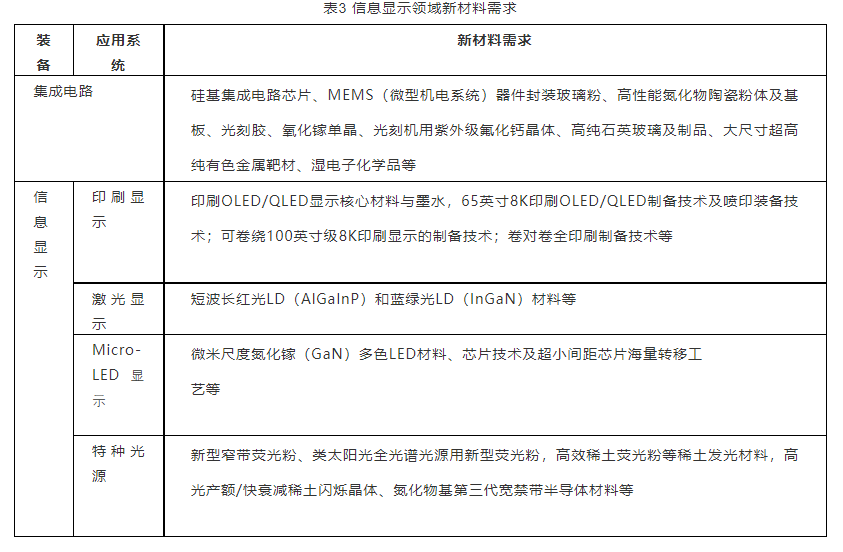
(4) The field of life and health
With the aging of the global population, people's attention to their own health continues to increase, and the health industry has entered a period of accelerated development. The rapid breakthrough of biomedical materials will bring benefits to human beings in rapid disease diagnosis and human organ repair and transplantation, and will have a vital impact on national medical safety and people's health. The demand for new materials in the field of life and health is shown in Table 4.
4. The development strategy of a strong country with new materials
(1) General idea
Guided by Xi Jinping’s Thought on Socialism with Chinese Characteristics for a New Era, fully implement the spirit of the Party’s “19th National Congress”, face the strategic blueprint for building a strong country in science and technology and a strong manufacturing country, based on the major needs of the national economy and national defense security, to improve independent innovation of new materials Competence as the core, with advanced basic materials, key strategic materials, and cutting-edge new materials as the development focus, adhere to supply-side structural reforms, adhere to sustainable development, vigorously develop new technologies, new models, and new business formats, and realize the transformation, upgrading and structure of the new materials industry Adjust, drive development by innovation, establish an independent innovation system for new materials with enterprises as the main body and deep integration of "production, study, research and application", comprehensively improve my country's new material independent guarantee capability and market competitiveness, and build my country into a new material power.
(2) Development goals
By 2025, the overall technology and application of key new materials will be synchronized with the advanced level, and the quality and stability of new material products will be comprehensively improved. The proportion of mid-to-high-end products will increase significantly, and the overall level will enter the middle and high-end links of the global value chain; key high-end materials and The level of independent research and development of high-end equipment and independent support capabilities have been improved, and the problem of key short-board materials being restricted by people has been effectively alleviated.
By 2035, focusing on the major needs of ensuring national security, industrial security, and technological security, the problem of core systems and key devices being controlled by people will be basically resolved; for device and material requirements related to the national economy, people’s livelihood and national security key areas, a systematic and comprehensive approach will be established. The ability to support and guarantee; comprehensively enhance the international competitiveness of the materials industry, and basically establish an independent innovation system for materials.
By 2050, it will be in the forefront of the world's material powers, with an independent material innovation system fully established, material research and development capabilities and industrial competitiveness at the global leading level; material development will fully meet the needs of national economic construction and national defense security, and support human economic and social development.
(3) Development focus and development direction
1. Advanced Basic Materials
The development focus and development direction of advanced basic materials mainly include advanced steel materials, advanced non-ferrous metal materials, advanced petrochemical materials, advanced building materials, advanced light industrial materials and advanced textile materials (see Table 5).
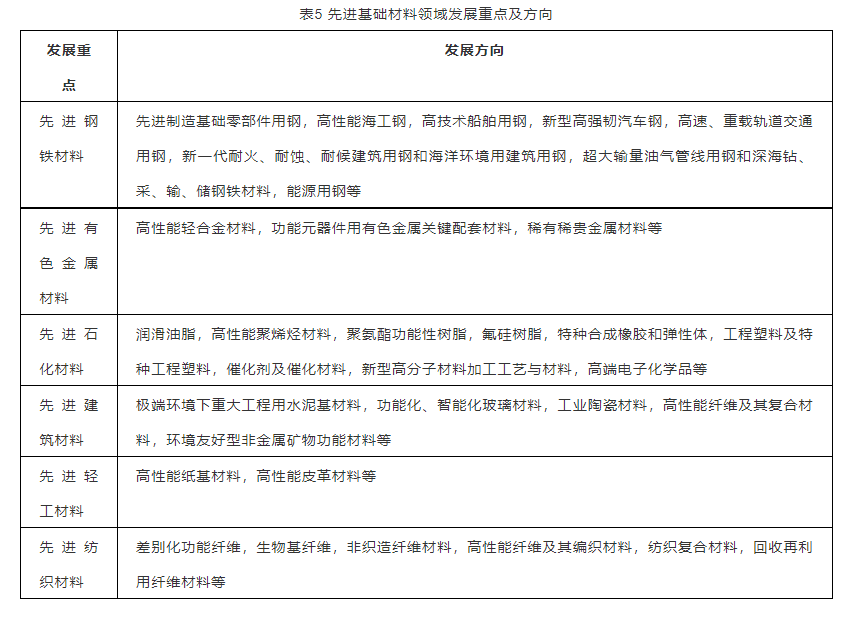
2. Key strategic materials
The development focus and development direction of the key strategic materials field mainly include special alloys for high-end equipment, high-performance fibers and their composite materials, new energy materials, advanced semiconductor materials, chip manufacturing and packaging materials, rare earth functional materials, electronic ceramics and artificial crystals, advanced Structure-function integrated ceramics and functionally graded materials, high-performance separation membrane materials, new display materials, new-generation biomedical materials and bio-based materials, etc. (see Table 6).
3. Cutting-edge new materials
The development focus and development direction of the frontier new materials field mainly include 3D printing materials, superconducting materials, smart bionic materials, graphene materials, etc. (see Table 7).
4. New material evaluation, characterization, and standard platform construction
New material evaluation, characterization, and standard platform construction mainly include key development directions such as the construction and improvement of platform basic elements, mechanism construction and improvement, and key tasks of platform operation (see Table 8).
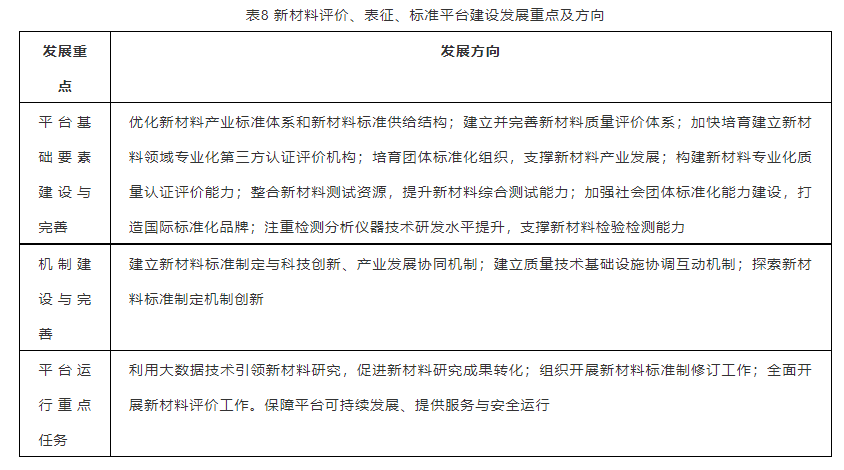
5. Policies and safeguards
(1) Building an independent innovation system for new materials
Build an independent innovation system with enterprises as the main body, and promote the resource integration and planning layout of the state key laboratory in the field of materials. Build a national manufacturing innovation center in key material fields such as graphene, lightweight materials, new rare earth materials, advanced composite materials, cultivate new industrial technology research institutes in the material field, coordinate the construction of new materials collaborative research institutions, and strengthen the Ministry of Science and Technology, industry and The Ministry of Information Technology, the Development and Reform Commission and other ministries and commissions organize and coordinate to form a joint work force, rationally allocate innovation resources, and avoid the dispersion of innovation resources in the field of new materials and the repeated construction of innovation carriers.
(2) Strengthen the construction of new material digital R&D platforms, production application platforms, and resource sharing platforms
Vigorously promote material genetic engineering, build a digital research and development platform for materials, promote the integration of material genetic engineering into the full life cycle of new materials research and development, design, manufacturing and application, shorten the research and development cycle of new materials, and reduce research and development costs. Improve the national-level production and application demonstration platform, solve the problems of core material production and application technology development, application technology service environment evaluation, production and application demonstration line construction, resource database sharing, etc., and promote the innovative development of new materials application technology. Strengthen the construction of a new material resource sharing platform, gather and process massive data resources such as new material products, enterprises, agglomeration areas, capital projects, achievement awards, academic documents, standards, patents, and experts, and build a new material industry knowledge service system; Material, instrument and facility sharing system to realize online interconnection and service sharing of key instruments and facilities.
(3) Building a policy system that promotes the development of new materials
Improve fiscal, taxation and financial policies, increase fiscal, taxation and financial support, and improve investment and financing mechanisms. Vigorously implement the intellectual property strategy, set up a national intellectual property special fund, focus on key technological breakthroughs in the industry, transform core technological achievements into intellectual property rights, strengthen intellectual property protection, and enhance the efficiency of intellectual property operations. Actively give play to the guiding role of government procurement and other policies, and encourage the use of the first batch of application demonstration catalog products of new materials in important industries and key industries that are the lifeline of the national economy, major infrastructure, and major construction projects. Improve the import and export policy system, maintain a fair trade environment, support new materials companies to use trade remedies, antitrust and other methods to maintain fair competition order, and guide and support new materials companies to deal with trade frictions. Establish a fault-tolerant and incentive mechanism for the first batch of applications of new materials, study the establishment of a fault-tolerant mechanism for government investment funds, increase support for the field of new materials, and speed up investment decision-making on the premise of ensuring the safety and stability of funds.
(4) Improve new material standards, testing, characterization, and evaluation systems
Establish a standard system that supports the high-quality development of the new material industry, carry out new material standards piloting actions, increase the effective supply of advanced basic materials, key strategic materials and cutting-edge new material standards, and give full play to the leadership of standardization in the development of the new material industry and quality changes effect. Improve the new material testing, characterization, and evaluation system, establish a national new material testing and evaluation platform, build a new material testing and evaluation system, and solve the bottlenecks and shortcomings of new material testing and evaluation. Vigorously cultivate and develop independent certification and testing brands to enhance international competitiveness.
(5) Cultivate a team of talents suitable for the development of the new material industry
While attracting foreign new material innovative talents, we must also increase the training of domestic new materials talents to form a sustainable talent supply model. In the field of basic research on new materials and major global issues, actively initiate major international scientific plans and projects, and build world-class new materials scientific research platforms/projects, which can attract foreign scientists and teams to participate, overcome scientific research difficulties, and provide scientists with the ability to perform A career platform; for major scientific and technological projects of new materials that do not involve state secrets, foreign talents can be attracted to participate in research. Continuously improve the evaluation mechanism of my country's new materials talents, overcome the tendency of only papers, professional titles, academic qualifications, and awards, and focus on the quality, contribution and influence of iconic achievements. It is recommended to adjust the scientific and technological evaluation mechanism of talents, and through relevant incentive methods, so that scientific and technological personnel can reflect their value in the transformation of achievements.




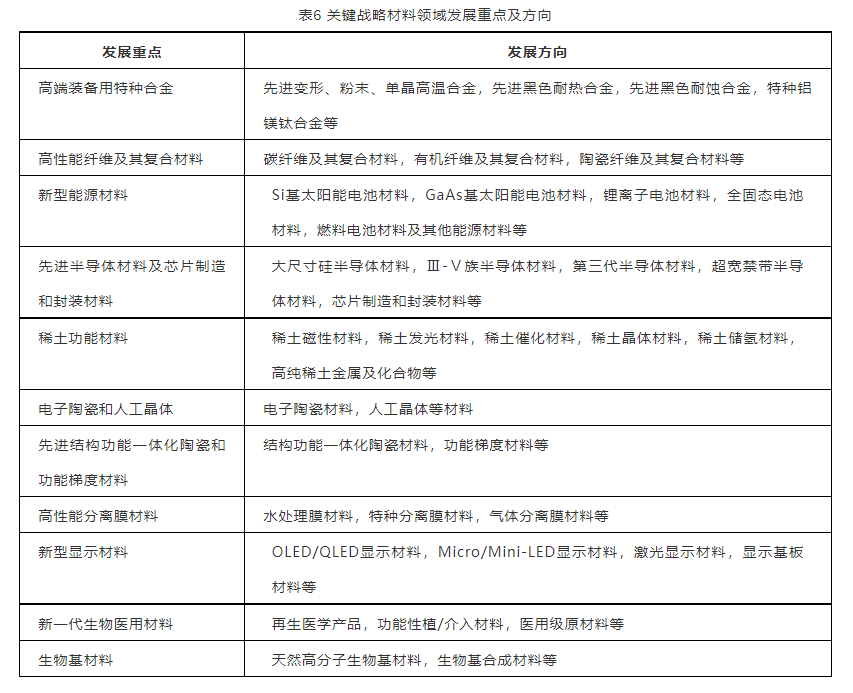
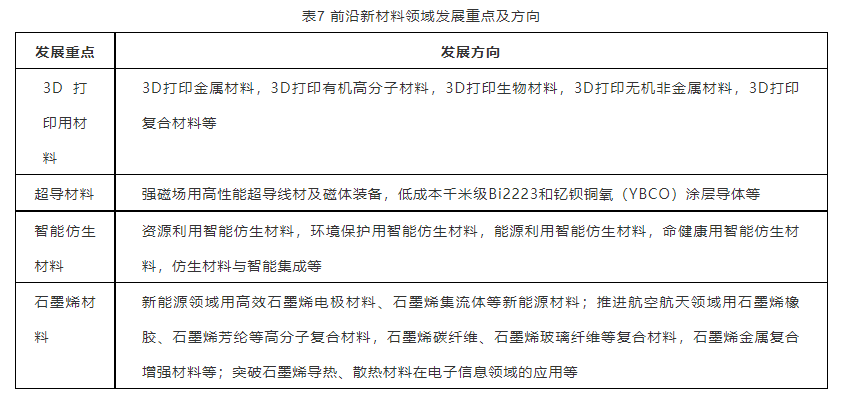

 TEL
TEL